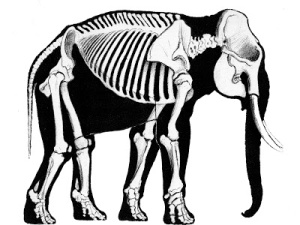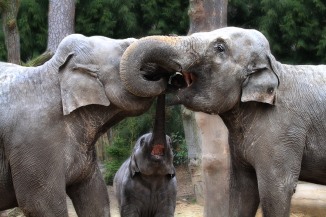Because why not? A trip to Asia isn’t complete without an elephant ride. Right?
No.
There are an overwhelming number of reasons why you should never ride an elephant, ranging from their physiology to how humans treat them.
Just like most wild animals, elephants naturally avoid humans. They’re not as skittish as some animals, but neither do they look to humans for interaction. Just like horses, elephants need to be broken in order to be ridden. But unlike horses, elephant breaking involves a lot more pain, beating and mistreatment.
It is easier to break a baby elephant, but in order to do that you must catch it and then separate it from its mother. This can be done using a ‘pit trap,’ where wild elephants are corralled into a corridor ending in a pit by domesticated elephants and riders. Unwanted elephants, typically protective mothers and other females, will be shot and sold.

This mother and calf were rescued from this pit recently. In India, pits have been banned, but they were never filled in. Now that they are not in use they do not get regularly checked, and therefore an elephant may become trapped and not be found for days.
Once an elephant has been captured it is no longer categorised under the Wild Animal Reservation and Protection Act of 1992 (WARPA) guidelines, losing them any protection. In captivity they are classed as livestock, just like cattle and sheep, and not recognised as the endangered animals that they are. This leaves elephants vulnerable to the breaking in process called ‘the crush.’

All captive elephants are put through this, tied alone in a small pen, beaten with bullhooks and bamboo, deprived of food and water and taught the basic commands that its captors require. During this time, the elephant’s spirit is broken and its naturally strong family bonds are lost.
This process is only the first of many tortures that elephants will have to endure throughout their life in captivity. Elephants are beaten whenever they do something ‘wrong,’ bearing the scars for the rest of their lives. They have to cope with the weight of a howdah (a large carriage situated on their backs) or saddle with typically 2 tourists, plus their mahout, who tends to sit on their neck. The average elephant can carry 150kg, and with a howdah weighing around 100kg, this should leave space for only one small person. Many tourists operators will not remove the howdah all day, which is not only a heavy burden, but can lead to sores, particularly around the legs and tail where they are tied on with ropes.
Elephants have long vertebrae in their spines. A howdah or saddle placed on top of theses creates a lot of concentrated pressure and therefore a lot of pain.

You can see from the image that there is very little padding between the vertebrae and the elephant’s skin. Mahouts tend to sit on the elephant’s neck, where the bones are not so close to the surface, making it more comfortable for the elephant. This should be the only place you sit on an elephant if you ever have to.
Asian elephants are highly social animals. They maintain complex relationships with other elephants, even those that they may not have seen in over a year. Just like humans, elephants have emotions, form bonds with friends and family and require time to socialise.

As part of riding camps, elephants are given very little time to themselves, and even less time to spend with other elephants. Imagine spending your life in solitary confinement whilst being beaten and forced to carry heavy loads.
It seems to be coming to people’s attention more and more that these animals are struggling in poor conditions. Cases of asian elephants killing their mahouts have been increasingly reported in the news, but is it really that much of a surprise that these usually gentle giants are having to resort to such extreme measures to escape?
There are plenty of charities that are doing their best to raise awareness, money and provide a safe haven for rescued elephants. The charity I am interning with next year, GVI, is just one of many charities rescuing and protecting elephants. You can help the elephants by supporting my internship and these charities:


Love this article. Unfortunately, whilst in Thailand, I went for an elephant ride. The whole thing was an ordeal and I couldn’t shake the feeling that something was wrong… when I got home, I googled it, and realised what a horrible industry I had supported. Articles like this need to be shared to raise awareness – I’m sure that like me, most people wouldn’t ride elephants if they knew the truth! xoxo
LikeLiked by 1 person
Thank you for your comment! At least you realised and educated yourself afterwards. There are many people who wouldn’t and would just keep on going back to places like these. That is exactly the problem, people do not know about the problems. I wanted to ride, but I was lucky enough to have seen the facts before my trip to Thailand, and now my mind is changed.
LikeLike
Jenna, this is such a well-written and fantastic blog post! We will definitely be sharing this on our social media.
Looking forward to meeting you at our Chiang Mai project as well 🙂
LikeLiked by 1 person
Thank you!
I look forward to meeting everyone there too, I can’t wait 🙂
LikeLike
I haven’t visited southeast Asia yet, but I know if and when I do visit there will be at least two things I won’t be doing; riding an elephant or petting a tiger. Great post, and really great blog! I love nature and adventure tourism but it has to be sustainable and with minimal impact to the wildlife we’re paying to see. I swam with whale sharks in Exmouth recently and actually stayed next door to the Ecocean research crew – conservationists are such lovely, passionate, generous and hopeful people! https://stillnotajournal.wordpress.com/2015/08/26/swimmin-with-whale-sharks-ningaloo-coast-western-austrayee-hah/
LikeLike
The tourist petting industry is terrible isn’t it. It’s the way they trick people into thinking the animals are in good conditions, when really they’re just being raised to be trophy hunted.
Thank you so much for your lovely comment!
Oh wow, that sounds amazing. Whale sharks are incredible creatures.
LikeLike
Hi Jenna, Thank you so much for the informative article! I’ve just started studying animal welfare and wanted to ask you about elephant back rides in Africa and if you think they are just as ethically concerning. I ask because I actually rode an elephant some time ago in South Africa with a sanctuary that rescued ele’s from a culling operation. The elephants were trained using positive reinforcement under the training regimen created by the well known elephant sanctuary in Little Rock Arkansas, US. The rescued elephants have free roam of the sanctuary which was a very large reserve, and even mate with wild elephants. They do the safaris for two hours a day then the rest of the time they roam free. The funds go right back into their conservation and care. I did my research prior because I know there are places that cannot be trusted and use negative training methods. Do you feel in your opinion, that this type of scenario is appropriate, where the welfare of the animals has been thoroughly considered, or would you not agree with any type of work an elephant may be asked to do? I would love to hear your thoughts. Thank you so much,
Ashley
LikeLike
Hi Ashley. Thank you for your really thought provoking question, and also thank you for taking the time to read my blog. I haven’t done much research into African Elephants being ridden, but I’ll try to answer as best I can.
As you have said, these elephants have been rescued from a cull, which is clearly positive for them. In my mind the preferable result for these elephants would be release back into the wild, if that is where they came from originally and if they would be able to survive there. If this was not possible, then of course placement into a sanctuary/reserve where they are cared for is the next best thing. From your description, the elephants do seem to be well looked after.
One of my concerns is that African elephants are notoriously more aggressive than Asians, so I wonder what has made them submissive to humans. At home we practise intelligent horsemanship with our horses so I wonder if it is a similar thing has been practiced on these elephants. I don’t know much about the training regime you have mentioned. Did you see any training being performed?
Personally I would never ride any elephant, as they cannot tell you what they are feeling very clearly! I think a scenario like yours is very complex and comes down to personal choice at the end of the day. It raises complex questions over how much power we have over animals, whether we should be asking them to do anything for us in the first place or not.
I found it challenging to write this blog post in order to not be contradictory, as I do ride horses, so what kind of power should I have over horses that I will not allow myself to have over elephants? Maybe that’s just because of social norms and how I have been brought up. My argument was that the horses are not harmed, but your scenario is also showing that elephants do not need to be harmed to be ridden either.
I’m sorry I haven’t given a particularly clear yes/no answer! It’s always good to discuss these things though, especially as it can bring to light new and interesting ideas.
Jenna 🙂
LikeLike
I appreciate your response. The amazing thing about this group was that even after being in a wild type environment, and mixing with wild conspecifics, they still choose to return to camp each day, and follow the guides without leads, or tools. It was quite impressive to see. I did not see the actual training, but I did learn that veterinarians had input to the training regimen, and a representative from the David Sheldrick Trust was impressed with the program. So that says a lot to me. That’s interesting about the behavior of African ele’s vs Asian. Makes me want to research that further. I will say that had I the opportunity to do it again now, I would probably choose against it, even knowing they were well looked after. For the same reasons you mentioned…about not knowing how it makes them feel. And mostly because I find myself more aware of these types of situations now than I was before.
The difference with horses is that we may subconsciously find it more acceptable because for centuries they provided humans with a means of transportation. It’s part of our history. And I suppose if anyone ever had to rely on an ele for transport, they would ride on the neck, and not the back, as you have pointed out.
I completely understand your dilemma in responding with a direct yes or no. It’s a difficult one. We have domesticated dogs for our personal use and companionship, as well as horses, among others. But what I think is important, in any of these types of situations in which we utilize animals, is animal welfare. We need to educate ourselves, as you have helped to illustrate in the above post, to ensure we are not supporting any of these ventures in which animals experience very poor welfare, cruelty, and neglect. Thank you for calling more attention to that!
LikeLiked by 1 person
Thank you for writing this informative article- I’m glad people are realizing that riding elephants is not a good choice when traveling.
LikeLike
Thank you! I’m glad they are too, hopefully this practise can be phased out soon.
LikeLike
Elephants are so beautiful and do not deserve to be exploited! I love this article!
LikeLike
Thank you!
LikeLike
Hi! Great article. I am so close to booking with GVI myself but from looking at pictures/videos on instagram I see that the mahouts at GVI thailand carry bullhooks rounc with them. This is making me very nervous about booking. Can you please help? Thank you.
LikeLike
Hi Jade, my apologies at being so slow to reply! Some of the mahouts do carry bullhooks with them, however I have never seen a GVI mahout use a bullhook in a way that would harm an elephant. If they ever are used, which is rarely, it is normally just to guide the elephant, never to hit them. Elephants can be dangerous and so they are also carried for safety. I hope that helps, and please feel free to ask any more questions!
LikeLike